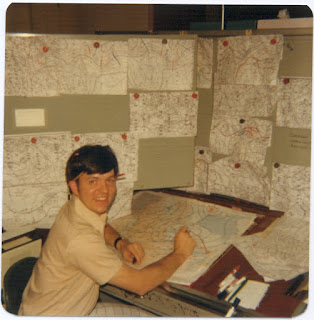 |
| #1828 "Just Another November Sunset" Pixels Link |
Surprisingly meteorologists did not really understand what shaped the moisture in the atmosphere. In 1977 the thrust was into modelling of the atmosphere in the burgeoning computer age. Great strides were being made as supercomputer technology raced forward. It was very inspiring but not where my mind was... and I did not have access to those computers.
I was more interested into applying the human computer to answer some of these very basic questions. Then along came satellite imagery … The artistic, right side of the brain was all anyone needed and I played some mental imaging games every time a cloud came by - which was very frequently. An updated analysis and diagnosis of the real, physical atmosphere was available with each new image. A meteorologist could easily understand what was really happening in the atmosphere and get the jump on any computer model and construct a better forecast. Imagine the power!
I started simply with pure rotation. All of this was completed within the atmospheric frame of reference which was described in “Why are clouds shaped the way they are?". I used water vapour imagery for reasons that I will make clear someday but not today.
The accompanying animations (if they work) are worth thousands of words in describing how cyclonic swirls shape moisture in the atmosphere. The blue arrows represent the simplified atmospheric frame streamlines or wind and the size of the arrow correlates with the relative speed of that wind. In these graphics, the letter “R” is used to locate the centre of rotation resulting solely from curvature in the flow. The letter “S”, which will come, locates the centre of rotation resulting solely from wind shear. Together, curvature and wind shear cause the moisture to spin and their combined effect results in a centre of rotation located by the letter “X” denoting cyclonic rotation. The relative font size of the "R" and "S" is related to their relative contributions to the total spin.
 The red “X” is considered to be positive or cyclonic (counter-clockwise in the northern hemisphere) rotation of the atmosphere. The resultant cloud edges are actually two cyclonically curved arcs that meet smoothly at the centre of rotation. Pointing your right thumb upward at an “X” also points your fingers in the direction of the cyclonic rotation of the atmosphere.
The red “X” is considered to be positive or cyclonic (counter-clockwise in the northern hemisphere) rotation of the atmosphere. The resultant cloud edges are actually two cyclonically curved arcs that meet smoothly at the centre of rotation. Pointing your right thumb upward at an “X” also points your fingers in the direction of the cyclonic rotation of the atmosphere.
The other type of rotation is
caused by wind shear. The streamlines that create cyclonic shear rotation are
straight. The speed shear alone induces the rotation. Frames of reference with speed shear must translate relative to the
earth. In the accompanying graphic the area of the rotation would translate to
the right at the average speed of the vectors. The centre of rotation for speed
shear is adjacent to the maximum wind. Looking downstream, a vorticity maximum is to the left of the wind maximum and a vorticity minimum is to the right.
Following the flow along the cyclonic arcs still meet at the centre of rotation. The point of inflection is not smooth but is a cusp when speed shear rotation is added into the mix.
Stronger wind shear creates a more pronounced cusp and the
sharpness of this cusp increases both with time and the intensity of the wind
shear. The vorticity centre red "X" ends up closer to the original
position of the more dominant speed shear component "S".
If one practices this just a few times, you will understand cyclonic cloud shapes. Follow the cloud edges to the curvature of the arc changes. That is your centre of rotation.
More to come...

















